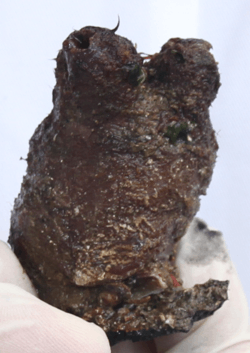Pyura doppelgangera
Pyura doppelgangera (doppelganger cunjevoi) is a sessile ascidian, or sea squirt, that lives in coastal waters of Australasia attached to rocks or artificial structures.
| Doppelganger cunjevoi | |
|---|---|
 | |
| Scientific classification | |
| Kingdom: | |
| Phylum: | |
| Subphylum: | |
| Class: | |
| Order: | |
| Suborder: | |
| Family: | |
| Genus: | |
| Species: | P. doppelgangera Rius & Teske, 2013 |
| Binomial name | |
| Pyura doppelgangera | |
Distribution
This species is particularly common in Tasmania.[1] It has also been reported from South Gippsland, Victoria (Port Welshpool and Port Albert), South Australia (Adelaide) and the extreme north of New Zealand's North Island.[1] Genetic data from rapidly mutating microsatellites indicate that the species is native to Tasmania and that all non-Tasmanian populations were introduced through human activities during the period of European settlement.[2] The invasion success of the introduced populations varies depending on the presence of suitable substrates. While the species is rapidly expanding its range in New Zealand (where rocky shore habitat is continuous), the invasion of South Australia has stalled because the region mostly has sandy beaches, and settlement is limited to artificial structures.[3]
Description
Pyura doppelgangera usually does not grow taller than about 50–60 mm. It has a brown tunic that has sand embedded in it.[1]
Taxonomy
Pyura doppelgangera is a member of the "P. stolonifera species complex", which includes at least five species of large, solitary ascidians that are all often incorrectly referred to as P. stolonifera in the literature. It shares a recent ancestor with P. praeputialis,[1] a larger species commonly referred to a "cunjevoi" or "cunjie", which is common in coastal areas of the south-eastern Australian mainland and which is a non-indigenous species in Antofagasta, Chile. Although a difference exists regarding the maximum body size of these closely related species, they are indistinguishable externally.[1] Genetic methods have recovered the two species as highly distinct evolutionary lineages.[1][4]
Etymology
The species is named Pyura doppelgangera after the German word Doppelgänger, which in its narrowest sense means "look-alike" (i.e. somebody who closely resembles somebody else). The name reflects the difficulty in distinguishing this species from P. praeputialis because of their very similar morphology.[1]
References
- Rius, M., and Teske, P. R. (2013) Cryptic diversity in coastal Australasia: a morphological and mito-nuclear genetic analysis of habitat-forming sibling species. Zoological Journal of the Linnean Society 168:597-611; article available at https://sites.google.com/site/drpeterteske/all-publications.
- Teske, P. R., Sandoval-Castillo, J., Waters, J., and Beheregaray, L. B. (2014) Can novel genetic analyses help to identify low-dispersal marine invasive species? Ecology and Evolution 4(14): 2848-2866; article available at: http://onlinelibrary.wiley.com/doi/10.1002/ece3.1129/full.
- Teske, P. R., Sandoval-Castillo, J., Sasaki, M., and Beheregaray, L. B. (2015) Invasion success of a habitat-forming marine invertebrate is limited by lower-than-expected dispersal ability. Marine Ecology Progress Series 536:221-227; article available at: https://sites.google.com/site/drpeterteske/all-publications.
- Teske, P. R., et al. (2011): "Nested" cryptic diversity in a widespread marine ecosystem engineer: a challenge for detecting biological invasions. BMC Evolutionary Biology 11:176; doi:10.1186/1471-2148-11-176; article available at: http://www.biomedcentral.com/1471-2148/11/176
External links
- Invasion of North Island, New Zealand, by Pyura doppelgangera • 3 News, 12 August 2010.